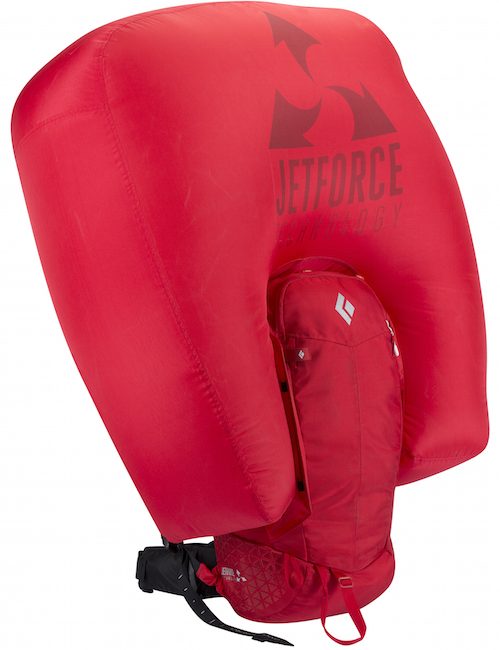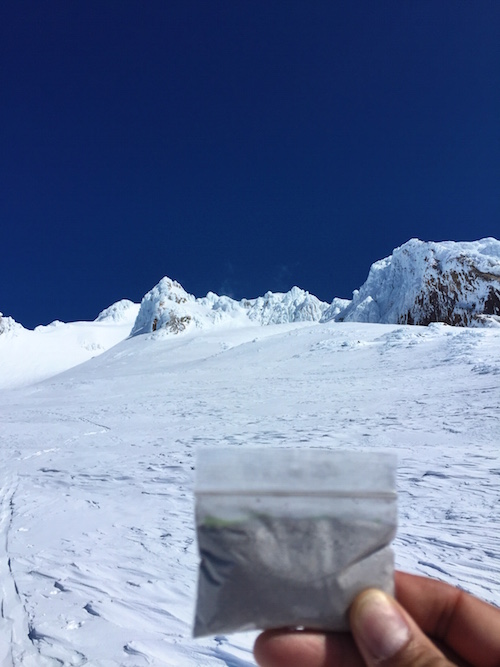I spied an interesting image in a recent issue of Backcountry magazine: Professional skier Nina Hance wearing both a Backcountry Access Float avalanche airbag backpack and a Black Diamond Equipment Avalung II artificial air pocket sling.
Although wearing both probably lessens risk of injury and death compared with wearing just one, the practice of doubling up has not been widely adopted. Wearing both an Avalung and airbag backpack is a bit laborious: travel in tight or technical terrain can be problematic with a larger, heavier pack — and donning and doffing both can be laborious.
Enter the new Black Diamond JetForce avalanche airbag backpack: it is inflated and deflated with a battery-powered fan, which may obviate the need for wearing both devices.
The JetForce works to prevent avalanche trauma and snow burial like all airbag backpacks. In addition, great potential exists to delay carbon dioxide displacement asphyxia by creating an artificial air pocket underneath the snow after an avalanche.
Trauma and Burial
Avalanche airbag backpacks have been around in Europe for about three decades. However, adoption in North America has been fraught with difficulties.
The packs are costly and heavy. The compressed gas canister has been cuffed with import regulations. U.S. airlines prohibit flying with full canisters: replacing and refilling canisters is costly and time consuming. Multi-day trips may obligate a backup canister in case of multiple deployments.
Avalanche airbag backpacks work by two mechanism. First, given the large volume of cushioning surrounding the head and neck, airbag backpacks help minimize trauma, which accounts for 25% of avalanche deaths.
Second, more to the point, the inflated airbag increases the volume of a person wearing it. This employs the principal of particle segregation called sifting, often referred to as inverse segregation, when larger particles rise to the top of a collection of moving particles.
If you get buried in an avalanche in the backcountry, the extra buoyancy you get from an inflated airbag could save your life.
Air Pocket
Whereas all airbags help prevent trauma and burial, the new JetForce also potentially creates an air pocket. The goal is to prevent deaths from carbon dioxide displacement asphyxia, or re-breathing expired air.
The JetForce uses a fan powered by a rechargeable lithium ion battery to inflate the airbag; after three minutes, the fan reverses to deflate the bag. This may create an air pocket under the snow and allow the buried person to continue breathing – although at this point it remains a largely unproven hypothesis.
Until recently, the Avalung was the only commercially available artificial air pocket device, made in a sling worn over clothing or incorporated into a backpack. The Avalung works by shunting expired carbon-dioxide-rich air to the back, and drawing in oxygen-rich air through a chest port.
But few people wear both the Avalung and an airbag backpack. The Jetforce is the first product designed to address both problems: to lessen the immediate trauma of burial, and to prevent asphyxia. Aside from avalanches, a possibility exists that the air pocket created by the JetForce also might help delay asphyxia for people submersed in non-avalanche deep snow or tree wells.
The Jetforce
Compared to similar canister packs, the JetForce weighs more (the JetForce Halo 28 clocks in at 7.5 pounds) and costs more ($1250-$1300). But JetForce backpacks can be taken on an airplane. The lithium-ion battery allows at least 4 deployments or 120 hours of standby with a single charge. Practice is free: I deployed the JetForce multiple times in my living room and at a Mount Hood Sno-park.
Canister airbag backpacks are still a great option. Cost is decreasing, availability is increasing, and refilling and replacing canisters is easier. I’ve refilled and exchanged canisters in Chamonix, Davos, and Portland, Oregon. Moreover, Scott Alpride system uses carbon dioxide and argon in small, inexpensive, airline-friendly cartridges similar to those used in personal flotation devices.
It is too early to tell whether the JetForce will become standard issue. But the added function of a potential air pocket may dramatically increase safety.
Dr. Christopher Van Tilburg is purveyor of prokit.info and author of Mountain Rescue Doctor and Adrenaline Junkie’s Bucket List.
Last modified: April 7, 2015



